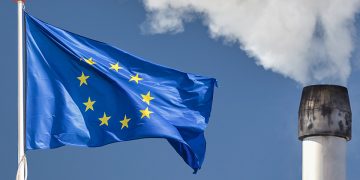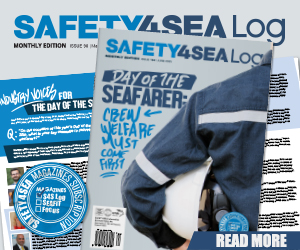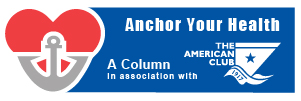During the 2025 SAFETY4SEA Limassol Forum, Marinos Ioannou, Dromon Bureau of Shipping, addressed the latest developments in EU regulations for maritime greenhouse gas (GHG) emissions and the challenges of their implementation.
As the maritime industry navigates the transition to a more sustainable future, the European Union (EU) and other international bodies have set ambitious targets to reduce greenhouse gas (GHG) emissions and achieve net-zero emissions by 2050.
To support these goals, several regulatory frameworks have been introduced, including the EU MRV, ETS, and Fuel EU regulations. These measures aim to drive decarbonization in the shipping sector by promoting the use of renewable fuels, clean technologies, and efficient operational practices.
EU 2030 & 2050 Goals
The EU aims to become the first climate-neutral continent, with a goal to reduce emissions by at least 55% by 2030 and achieve net-zero emissions by 2050 under European Climate Law.
As part of the European Green Deal, the Fit for 55 legislation package was introduced, including the EU MRV regulation, which now serves as the basis for the EU ETS system.
The Fuel EU Maritime Regulation, which entered into force this year, promotes renewable low-carbon fuels and clean energy technologies for ships. On the international stage, the IMO’s 2030 Agenda for Sustainable Development also sets a target of net zero by 2050.
EU MRV / ETS
Regarding EU MRV and ETS, this year marks the first verification at the company level, with the surrender of verified GHG emissions under the EU ETS for cargo and passenger ships over 5,000 gross tonnage.
Offshore vessels over 5,000 GT are also subject to EU MRV regulations, though surrendering won’t be enforced until 2027. Smaller ships between 400 and 5,000 GT are now included, with further consideration for inclusion in the EU ETS in the coming years.
There are various challenges with implementing EU MRV and ETS, and I’ll highlight a few key issues. First, the verification deadline has been moved up to March 31, reducing the time for submission and verification.
Additionally, verified data must be submitted to the authorities by May 31. The extension of the EU MRV regulation to smaller ships will create a learning curve, as we’re onboarding new companies to this field.
The extension of the EU MRV Regulation to offshore and smaller cargo ships is expected to create a phase-in learning curve. We already encounter this not only with the need to transfer existing knowledge to companies now entering this field, but also to new challenges the regulation creates such as the following one.
Change of ownership is another issue that will now extent to the FuelEU regulation as well. The regulation requires the seller to complete the verification of emissions for the part of the year the vessel was under their responsibility and submit it to the buyer.
The buyer on the other hand as the responsible entity to submit on Thetis the annual aggregated emissions data, must make sure that the partial verification has been completed by the seller.
This issue was already discussed extensively in the EU since there are plenty of cases that the buyer did not manage to get such data from the seller exposing them to facing fines and detentions.
Fuel EU Regulation
On to the Fuel EU regulation, which is the most complex environmental regulation affecting shipping. It applies to cargo and passenger vessels over 5,000 GT, covering all energy used on voyages between EU ports and while at berth in EU ports, and half of the energy used on voyages between an EU port and a non-EU port.
The regulation accounts for the full life cycle of fuel emissions, from production to consumption.
As of 2030, onshore power supply (OPS) will be mandatory for container and passenger ships. Compliance will be verified annually, with options to reduce GHG intensity, such as biofuels or renewable fuels of non-biological origin (RNFBOs). However, these fuels come at a higher cost and often require vessel retrofits.
Moreover, wind energy is also incentivized as a green solution. Ships using electricity as primary propulsion may generate compliance surplus and sell it through a pooling mechanism.
If a vessel falls into compliance deficit, a penalty of €2,400 per ton of VLSFO energy equivalent will be imposed, with a 10% increase for consecutive periods of non-compliance. The EU aims to make penalties costly to encourage proactive compliance.
UK ETS
Looking at the UK, the UK Government has announced their intention to introduce the UK ETS for shipping from the 1st of January 2026 for ships above 5000GT.
Industry stakeholders have provided feedback to the regulators based on the lessons learned from the EU ETS up to now.
Some of the areas of concern are:
- Double payment and double reporting should be avoided as the same emissions should not be reported and paid for multiple times under different regimes.
- Responsible entity selection should mirror the same flexibility of the EU ETS which allows either the shipowner to take responsibility or to mandate the responsibility on the ISM Manager.
- Phasing of emissions should have a gradual approach similar to the EU ETS when it comes to surrendering allowances.
- Provide extensive clarifications on the inclusion of Offshore Vessels, taking into consideration the shortfalls of the EU ETS and the feedback provided from various industry stakeholders on the matter.
This raises concerns about double reporting and payments between different schemes, such as the UMRV and UKMRV. The responsible entity selection should allow shipowners to take responsibility or delegate it to the ISM manager, as seen with the EU ETS.
Stakeholders have also raised concerns about offshore vessel inclusion and the gradual approach to emissions surrendering.
The views presented are only those of the authors and do not necessarily reflect those of SAFETY4SEA and are for information sharing and discussion purposes only.
Above article has been edited from Marinos Ioannou’s presentation during the 2025 SAFETY4SEA Limassol Forum.
Explore more by watching his video presentation here below

































































